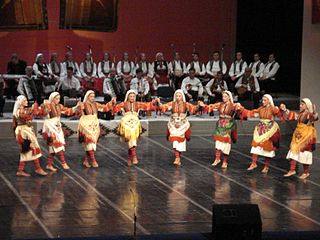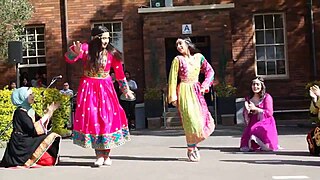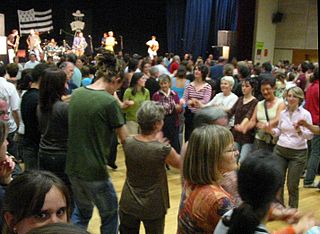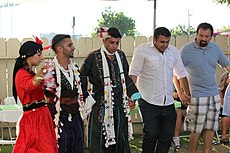
A folk dance is a dance that reflects the life of the people of a certain country or region. Not all ethnic dances are folk dances. For example, ritual dances or dances of ritual origin are not considered to be folk dances. Ritual dances are usually called "Religious dances" because of their purpose. The terms "ethnic" and "traditional" are used when it is required to emphasize the cultural roots of the dance. In this sense, nearly all folk dances are ethnic ones. If some dances, such as polka, cross ethnic boundaries and even cross the boundary between "folk" and "ballroom dance", ethnic differences are often considerable enough to mention.

Hora, also known as horo and oro, is a type of circle dance originating in Jewish communities and the Balkans but also found in other countries.

Circle dance, or chain dance, is a style of social dance done in a circle, semicircle or a curved line to musical accompaniment, such as rhythm instruments and singing, and is a type of dance where anyone can join in without the need of partners. Unlike line dancing, circle dancers are in physical contact with each other; the connection is made by hand-to-hand, finger-to-finger or hands-on-shoulders, where they follow the leader around the dance floor. Ranging from gentle to energetic, the dance can be an uplifting group experience or part of a meditation.

Kochari is a folk dance originating in the Armenian Highlands. It is performed today by Armenians, while variants are performed by Assyrians, Azerbaijanis, Kurds, and Pontic Greeks (kotsari). It is a form of circle dance.

Bulgarian folk dances are intimately related to the music of Bulgaria. This distinctive feature of Balkan folk music is the asymmetrical meter, built up around various combinations of 'quick' and 'slow' beats. The music, in Western musical notation, is often described using compound meter notation, where the notational meter accents, i.e., the heard beats, can be of different lengths, usually 1, 2, 3, or 4. Many Bulgarian dances are line dances, in which the dancers dance in a straight or curved line, holding hands.

Turkish folk dances are the folk dances of Turkey. Facing three seas, straddling important trade routes, Turkey has a complex, sophisticated culture, reflected in the variety of its dances. The dominant dance forms are types of line dance. There are many different types of folk dances performed in various ways in Turkey. Zeybek, Teke Zortlatması in Aegean region, Bar in Erzurum province, Halay in the central, southern, eastern, and southeastern parts of the country, Hora in Thrace, Horon in the eastern Black Sea region, Spoon dances in and around Konya, and Lezginka in Kars and Ardahan are some of the best known examples of these.
Locking is a style of funk dance, which is today also associated with hip hop. The name is based on the concept of locking movements, which means freezing from a fast movement and "locking" in a certain position, holding that position for a short while and then continuing at the same speed as before. It relies on fast and distinct arm and hand movements combined with more relaxed hips and legs. The movements are generally large and exaggerated, and often very rhythmic and tightly synced with the music. Locking is performance oriented, often interacting with the audience by smiling or giving them a high five, and some moves are quite comical.

Assyrian folk dances are sets of dances that are performed throughout the world by Assyrians, mostly on occasions such as weddings, community parties and other jubilant events.
The dance forms of Andhra Pradesh take on a wide variety of colors, costumes, and types; and involve different settings and musical instruments.

Attan is a traditional dance originating from the tribal Pashtun regions of Afghanistan and North Western Pakistan. It is now considered the national dance of Afghanistan. Some believe it has spiritual roots connecting it to Zoroastrianism. Others link the dance to the British occupation and the Pashtun resistance movement, when Pashtuns used the dance to instil confidence and energy among warriors readying to battle the colonisers. The Attan was also conducted by Pashtuns in times of war or during weddings or other celebrations. It is now considered the national dance of Afghanistan, popularly carried by other ethnic groups in Afghanistan as well as by the Pashtun ethnic group in Pakistan.

An dro or en dro is a Breton folk dance in 4
4. It is a form of a circle dance.

The Faroese chain dance is the national circle dance of the Faroe Islands, accompanied by kvæði, the Faroese ballads.

The Kalamatianós is one of the best known dances of Greece. It is a popular Greek folkdance throughout Greece, Cyprus and internationally and is often performed at many social gatherings worldwide. As is the case with most Greek folk dances, it is danced in chain with a counterclockwise rotation, the dancers holding hands.

Tamzara is a folk dance native to Armenian Highlands. It is today performed by Armenians, Assyrians, Azerbaijanis, and Greeks.
Assyrian folk/pop music, also known as Assyrian folk-pop or modern Syriac music, is the musical style of the Assyrian people derived from traditional music that includes a broad range of stylistic varieties, which would also encompass fusions of Western genres such as pop, electronic, Latin, jazz and/or classical music, with a melodic basis of Assyrian folk.
Lesnoto, or Lesno, is the name of a family of simple, popular folk dances from North Macedonia, also done in Bulgaria and parts of neighboring Balkan countries. It is a line dance, usually done to a seven-beat meter organized in a slow, quick, quick rhythm, often abbreviated 3+2+2. The common factor of all the forms is a pattern of "three steps to the right, one step to the left". These are probably the most common dances in the region, done at parties and mehanas (cafes) to both traditional and modern music.

Folk dances of Assam include the Bihu and the Bagurumba, the Bhortal, the Ojapali dance. Assam is home to many groups: Muslim, Indo-Aryan, Rabha, Bodo, Dimasa, Karbi, Mising, Sonowal Kacharis, Mishmi and Tiwa (Lalung) etc. These cultures come together to create an Assamese culture. Residents of the state of Assam are known as "Axomiya" (Assamese). Most tribes have their own language, although Assamese is the primary language of the state.
This is a glossary of terms used in fencing.

Russian folk dance is an important part of Russian culture. Some of the unique characteristics suggest that many elements were developed by the early Russian population.















